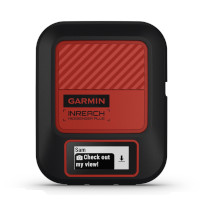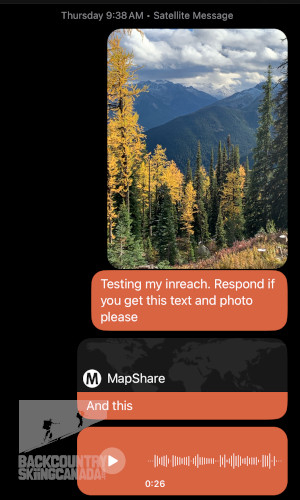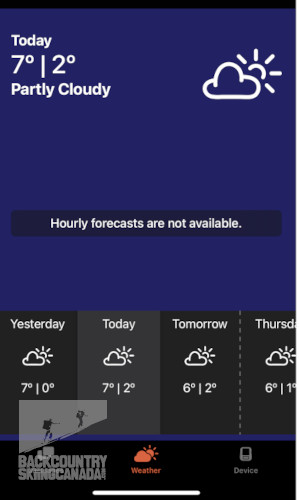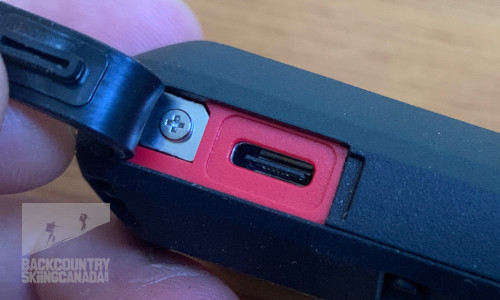


SITE LOGIN
-
REVIEWS
- Ski Gear
- Clothing
- Accessories
- Off-Season Gear
- Lifestyle
- Lodges and Accommodation
- Nutrition
- Manufacturers
- Destinations
- Training
- Gear of the Year
- Best New Summer Gear
-
Holiday Gift Guide
-
Holiday Gift Guide 2024
- Holiday Gift Guide 2024 Base Layers
- MSR Explore Revo Snowshoes
- Fieldsheer Backcountry Heated Jacket
- Fieldsheer Premium 2.0 Merino Heated Socks
- MEC Hut Booties and Slippers
- Arc’teryx Kopec GTX Shoe
- Arc’teryx Kragg Insulated Approach Shoes
- Gregory Verte 18 Backpack
- Grundens Deck-Boss Ankle Boot
- MEC Northern Light Vest
- Montec-Scope-Ski-Goggles
- Mountain Hardware Kor Airshell Hoody
- Mountain Hardware Kor Alloy Crew
- Arcade Atlas Belt
- Dynafit Ridge Dynastretch Jacket
- Shokz OpenRun Pro 2 headphones
- Buff Merino Move Multifunctional Neckwear
- Bootdoc Foot Warmer
- Cotopaxi Allpa 42L Travel Pack
- DPS LastBag
- DPS PHANTOM Glide At-Home Kit
- DPS Mission Quiver Roller
- Dragon Amped sunglasses
- Dragon DX3 Plus OTG photochromic goggle
- Fuse Lenses Anclote Flashback
- Garmin Fenix 8 Solar Sapphire Watch
- Gregory Alpaca Gear Tote 30
- Hotronic Boot Dryer
- MEC Aluminum Pot Set
- Gnara Go There Pants
- Grundens Shackleton 2.0 Duffel
- Jones Deeper 19L Backpack
- Le Bent Core Midweight Crew base layer
- Leatherman ARC
- Montane Nordes Hooded Softshell Jacket and Pants
- Helly Hansen Odin Everdown Hooded Jacket
- Helly Hansen Verglas Infinity Shell Jacket 2.0
- Montec Fawk Ski Jacket
- Pomoca Free Pro 2.0 Skins
- Rab Glaceon Pro Down Jacket
- Rab Khroma Converge GORE-TEX Ski Jacket & Pants
- Smith Squad MAG Goggles
- Stellar Guide Aerogel Hybrid Hood 2.0
- Stellar Ultralight Down Hood 2.0
- Arms of Andes Alpaca Half Zip & Wool Leggings
- Cotopaxi Allpa 70L Duffel Bag
- Giro Taggert Mips Helmet
- Loonr Hi Flyer Boots
- Paka Mountain Crew
- Roll Recovery SUPERPLUSH Classic Shoes
- Smartwool Smartloft Hooded Jacket and Pants
- Ortovox Switchback 32 Ski Touring Backpack
- Cotopaxi Allpa X 3L Hip Pack
- Giro Sagen Ski Goggle
- Icebreaker Ski+ Over the Calf Socks
- MEC-Fireside-Fleece-Snap-Pullover
- Montec Roast Mittens
- Mountain-Hardware-Sunblocker-Hoody
- MSR Titan Kettle 900 ml
- Tailgate-Industries-The Gondom-Goggle-Cover
- Wild Country Rope Tarp
- Bootdoc Race Merino PFI 50 Socks
- Remind Soles Destin Impact Insoles
- Kari Traa Rose Baselayer Half Zip Top and Pants
- Le Bent Midweight Quarter Zip
- Ombraz Dolomite Sunglasses
- Ortovox Fleece Rib Hoody
- Ortovox Merino Thermovent Base Layer
- Smartwool Intraknit Merino Tech Half Zip
- Suunto Wing Bone Conduction headphones
- Sweet Protection Adapter Mips Helmet
- Sweet Protection Connor Rig Reflect Goggles
- Zeal Optics Selkirk Glacier Glasses
- Norrona more flex1 Pants
- Norrona Octa Zip Hood
- Norrona Lyngen Alpha100 Zip Hood
- MEC Deluxe Pillow
- Holiday Gift Guide 2023
- Holiday Gift Guide 2022
- Holiday Gift Guide 2021
- Holiday Gift Guide 2020
- Holiday Gift Guide 2019
- Holiday Gift Guide 2018
- Holiday Gift Guide 2017
- Holiday Gift Guide 2016
-
Holiday Gift Guide 2024
- Pro Skier Interviews
- NEWS
- STORE
- ROUTES
- LODGING
-
VIDEOS
- 2022/23 Gear Reviews
- 2021/22 Gear Reviews
- 2020/21 Gear Reviews
- 2019/20 Gear Reviews
- 2018/19 Gear Reviews
- 2017/18 Gear Reviews
- 2016/17 Gear Reviews
- 2015/16 Gear Reviews
- 2014/15 Gear Reviews
- 2013/14 Gear Reviews
- 2012/13 Gear Reviews
- 2011/12 Gear Reviews
- 2020 Outdoor Retailer
- 2019 Outdoor Retailer
- 2018 Outdoor Retailer
- 2017 Outdoor Presscamp
- 2017 Outdoor Retailer
- 2016 Outdoor Presscamp
- 2016 Outdoor Retailer
- 2015 SIA Show
- 2014 Outdoor Retailer
- 2013 SIA Show
- 2012 Outdoor Retailer
- Tips and Tricks
- Backcountry Skiing
- SAFETY
- ABOUT
- REVIEWS
- NEWS
- STORE
- ROUTES
- LODGING
-
VIDEOS
- 2022/23 Gear Reviews
- 2021/22 Gear Reviews
- 2020/21 Gear Reviews
- 2019/20 Gear Reviews
- 2018/19 Gear Reviews
- 2017/18 Gear Reviews
- 2016/17 Gear Reviews
- 2015/16 Gear Reviews
- 2014/15 Gear Reviews
- 2013/14 Gear Reviews
- 2012/13 Gear Reviews
- 2011/12 Gear Reviews
- 2020 Outdoor Retailer
- 2019 Outdoor Retailer
- 2018 Outdoor Retailer
- 2017 Outdoor Presscamp
- 2017 Outdoor Retailer
- 2016 Outdoor Presscamp
- 2016 Outdoor Retailer
- 2015 SIA Show
- 2014 Outdoor Retailer
- 2013 SIA Show
- 2012 Outdoor Retailer
- Tips and Tricks
- Backcountry Skiing
- SAFETY
- ABOUT
TOP VIDEOS
Garmin InReach Messenger Plus
Last Summer Garmin released their InReach Messenger to much acclaim and this fall they’ve released a new version called the InReach Messenger Plus that comes with a few innovative new features, but do they warrant the $280 price increase?
Like the previous version, the inReach Messenger Plus uses the Iridium satellite network to send out SOS emergency messages, GPS coordinates, two-way messaging, and emails and track your adventures. This new ‘Plus’ version also allows you to send photos, text messages up to 1,600 characters long and voice messages up to 30 seconds long—all without cell coverage. This means that you don’t have to text someone highlights of your adventure you can tell them in a voice message or show them the view with photos. This makes your backcountry travel safer, more interactive and more fun to share.
- SHOW THE REST OF THE REVIEW / PHOTOS / VIDEOS
-
Garmin’s previous Messenger device used Short Burst Data (SBD) to send messages, but thanks to Messenger Plus’s new hardware which uses Iridium Messaging Transport (IMT) it can send messages 300 times larger than SBD. This is why you can now send photos, 30-second voice memos, and 1,600-character texts.
You can see in the image below that photos and audio messages can now be sent and you can still get weather updates like in the previous Messenger version.
Other satellite communication devices include the ACR Bivy Stick, Spot X 2-way and Zoleo Satellite Communicator but these are not capable of what the InReach Messenger Plus can do and have more limited feature sets. One feature that Garmin has included on the previous InReach Messenger and the new Plus version is the ability to charge your phone from the device itself via the USB-C charging port. In an emergency situation, you can use this “reverse charging” to provide the power you may need without completely draining the inReach Messenger as it will never let the device go below a 25% charge.
To get the full user experience from your Messenger Plus device be sure to pair your device with Garmin’s Messenger App which is available for Android and IOS phones. Once paired with the device it provides a much larger phone screen to text, email, track and check the weather from. If your phone fails you can of course send messages from the Messenger device itself but this is more time-consuming given the limited interface and small screen.
Data subscriptions range from $14.95 - $64.95/month and include 10/25/50 photos and 50/150/unlimited text and weather requests respectively per plan and there is also a 54.99 activation fee.
With the latest iPhone and Google Pixel now capable of sending text messages via satellite connectivity you may be asking why you would need the new Messenger Plus. For starters, you need the latest and greatest version phone along with the updates iOS and the satellite messaging feature is only free for two years—after that, it is not clear what the cost will be. Apple’s iPhone satellite messaging is currently only available in North America and uses the GlobalStar network which has limited coverage in Africa and Asia. So, if you want proven worldwide coverage with the ability to send voice messages, 1,600-character text messages and photos all wrapped up in a light, compact and very durable package then the Messenger Plus device is still the clear winner as far as robust safety devices go.
Features:
- NEW - Send images without cell coverage
- NEW - Send voice messages up to 30 seconds long without cell coverage
- NEW - Custom two-way text messages can be up to 1600 characters long
- Send customized pre-set text messages for anticipated situations for free
- Uses Iridium’s constellation of 66 satellites for coverage of the Earth's entire surface (GPS, GLONASS, BeiDou and QZSS)
- Rechargeable internal battery (able to send 250 media messages on a single charge)
- Garmin Explore app adds mapping capabilities and helps plan your trip and manage waypoints
- TracBack mode navigates you safely back to where you started
- Reverse charging allows you to charge your phone for 20 minutes from the USB-C port
- Smart network switching technology sends and receives messages via the most reliable available network only using satellites when needed
- GPS tracking via a personalized MapShare page you can share with friends
- World coverage SOS feature gives you a confirmation message from the International Emergency Response Coordination Center (IERCC) and 2-way texting allows you to stay in contact with rescue personnel
- Messages have your GPS location embedded for faster finding in emergencies
- Weather forecasting service sends detailed weather data for your location
- Monthly and yearly subscription plans
- The rugged design is IPX7 water-resistant and dustproof
- High-contrast on-device display
Verdict:
Garmin’s new Messenger Plus is an impressive upgrade over the previous version and has enough new features that warrant an upgrade if they are of value to you. Most people will be fine with limited text messaging capabilities and not need the ability to send voice messages and photos but after using these features I could not go back. It makes my communications much more rich and informative and feels like I am just using my cell phone in the middle of nowhere. While I could get by with the previous Messenger device, having used these new features I can honestly say that I enjoy using the Messenger Plus so much more than the previous version. The increase of the messaging character limit alone is worth it as now I can send longer messages and not have to try and be so succinct in my thoughts.
While I do like the ability to send photos and voice messages I did find that they do take several minutes to send given their larger file size. This delay can be annoying when you are used to sending text messages pretty much instantly and it also uses up more battery life in the process.
I do appreciate that the Messenger Plus is the same size and configuration as the previous version, however, it is 10 grams heavier—although you’ll never notice this. The battery life has also diminished slightly as it was 28 days with 10-minute interval tracking and is now reduced to 25.
The price of the new Messenger Plus is substantially higher than the previous version so these new features will set you back $280CAN. This will make the upgrade to the new Messenger Plus a bit more of a think for most people as that is a lot of cash to be able to send voice messages and photos. In addition to this, the data plans have increased in price as well so communicating in a more feature-rich environment will cost you over the long run.
 |
PROS:
|
 |
CONS:
|
SPECS:
Price: $679.99CAN / $499.99US
Size: 7.8 x 6.4 x 2.3cm / 3.1 x 2.5 x 0.9"
Weight: 117.2g / 4.1oz
Waterproof Rating: IPX7 (immersion in water up to 1 meter for up to 30 minutes)
Battery Life: Up to 25 days with a text message or location sent every 10 minutes, up to 250 Media Messages sent on a single battery charge
Charging: USB-C
Plans: $24.95 - $64.95/month
RATING: 8.5/10
Ease of Use: 1.5/2
Technology: 1.5/2
Features: 2/2
Weight/size: 2/2
Quality/Price: 1.5/2
Did we miss something? Are we totally out to lunch? Let us know what you think. People like/dislike gear for different reasons so chime in below and we'll get a well-rounded evaluation. You'll need to login or register before you can comment but it only takes a few seconds, then you're good to go.
Leave a Comment:
Copyright © 2023-24 Backcountry Skiing Canada. All Rights Reserved.
















